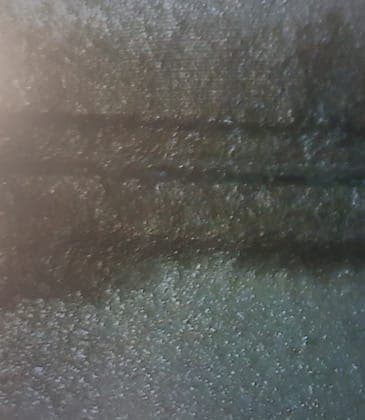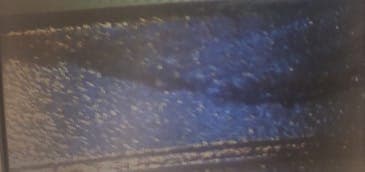
-----
Black spots found on nickel plated surface
Q. Hi,
Our major defect in the nickel plating line(using nickel sulphate ~80g/l, boric acid ~45 g/l, Nickel Chloride ~15g/l, pH 2-4) is black spots(with shiny tail).
Right now, we cannot figure out the root cause of the black spots. Whenever, we encounter this problem, we stop production and do the H2O2 and dummy plating, and we do the dummy plating every 3 days.
I would like to ask if anyone knows what's happening and can advise me on the solution.
Thanks in advance.
Thompson- China
2000
A. You do not mention what base metal you are plating on. This can have an effect on what the possible cause(s) of your problem are.
Have you determined which helps overcome the spotting more: dummying or peroxide treatment? If it is the peroxide treatment the problem would most probably be an organic contaminant or excess brightener component. If the problem is reduced by dummy plating it generally would be metallic in nature. If so, here is where the nature of the base metal comes into play!
Another possibility, especially if your treatments are not successful in mitigating the spotting, is the pretreatment cycle is not suitable for the base metal
Gene
Gene Packmanprocess supplier - Great Neck, New York
2000
Q. Hi,
The base metal are copper material also OFC materials. It is difficult for us to find out the root cause of the problems, as sometime the H2O2 and dummy plating cannot solve the problem.
The pre-treatment process is effective and I believe the black spots on the surface are not due to the dirt attached on the raw material which cannot be removed by the pretreatment process.
Thompson
Thompson [returning]- China
2000
2000
A. The treatments that you are putting your bath through, may or may not be solving the problem.
Suggest taking one (1) part and rubbing it down with powdered pumice ⇦ on eBay or Amazon [affil link] , all over. Rinse well and rack in the nickel tank. If black pits occur the cleaning in your tank can be assumed to be good. Pumice is an excellent manual cleaner, but too inefficient for use on a daily basis.
The peroxide adds you are making could cause the problem if residual peroxide exists in the solution. Cure: Heat the solution to about 160 °F. (making sure the tank lining will stand this temperature). This will decompose any excess peroxide that MAY be in the solution. Stop here if the problem goes away. Next. If the problem is organic and you know that a carbon treatment is needed. Use only powdered activated carbon in an auxiliary tank. Never perform this treatment in the plating tank. You will NEVER get the carbon out. If this does not quite remove the organics try this following suggestion. In your laboratory take a on e (1) Liter beaker [beakers on eBay or Amazon [affil link] of nickel solution from your tank. Add 1-3 drops of N-TriButyl Phosphate and mix at 150 °F for about 15 minutes. Add powdered Carbon needed for 1 liter and mix for 1/2 hour. Filter until all carbon is removed. Plate in a Hull Cell ⇦ huh? to see if black pits are removed. The N-Tributyl Phosphate puts some organics in a better form to be adsorbed by the Activated carbon. Remember, in your auxiliary tank, never leave the carbon in too long. The organics that are removed will eventually come off the carbon and recontaminate your solution. In a plating tank, I never used more than a capful in a plating tank. Hope this helps.

Ed Budman [dec]
- Pennsylvania
With deep sadness we advise that our good friend Ed passed away Nov. 24, 2018
May 31, 2013
Q. We have a bright Nickel Solution about 1500 gal and we are getting Brown Stains after plating and rinses (triple rinse).
The concentrations in the tank are:
Nickel (metal)= 9.8 oz/gal
Nickel Chloride= 13.15 oz/gal
Nickel sulphate= 29 oz/gal.
Boric Acid= 6.5 oz/gal.
Any clue about these brown stains or any suggestion? Thanks.
- Miami, Florida, USA
June 2, 2013
A. Hi E. Probably too much iron in the bath and/or the pH too high may be causing the rusting.
Regards,

Ted Mooney, P.E.
Striving to live Aloha
finishing.com - Pine Beach, New Jersey
Ted can be retained for immediate
answers or long term project help
June 3, 2013
Q. Thanks for the suggestion. I just received the results for the lab of metals contamination. These are the values:
Fe= 2.4 ppm
Cu= 0 ppm
Zn= 3.9 ppm
Ca= 237 ppm
Mg= 42 ppm
So once again... Any suggestion?
Thanks,
- Miami, Florida, USA
A. Hi.
Usually occurs when plating steel parts in a barrel. After cyanide copper strike then bright nickel plating the parts, the problem was solved.
- Penang, Malaysia
June 5, 2013
Multiple threads merged: please forgive chronology errors and repetition 🙂
Dark stains/marks after flash nickel plating
Q. Kindly advise possible reasons when dark stains/marks appear on thin nickel plating of nickel alloy casting. Solution is nickel sulphamate, nickel chloride and boric acid. Plate out using dummy plates for few days did not eliminate this problem. Solution analysis results show chemicals (total Nickel, total chloride, Boric acid) meet specifications. Black marks can be removed using scotchbrite
⇦ on
eBay or
Amazon [affil link]
and acetone
⇦ on
eBay
or
Amazon
[affil link] Flammable!
.
Surface cleaning is with dry SiC grit blasting, alkaline degrease, rinse, Etch with HCl and ferric chloride
⇦ on
eBay or
Amazon [affil link] , rinse, Desmut with HF and HNO3, rinse, Caustic clean, rinse, nickel strike (HCl and Ni chloride), rinse before the nickel plating bath.
Plating is to facilitate brazing. Thickness 0.0003" to 0.0007" (7.6 - 17.78 micron)
Engineer - Singapore
January 22, 2014
A. Hello YF Leong,
What current density are you applying? Do you use a wetting agent in the bath? If so, when was the last time a wetter was added? How is your pH? Has the bath been carbon polished or carbon treated within the last 6 months? What type of solution agitation do you employ? Are anodes bagged and free of holes? These are some troubleshooting measures you can check on. I had this same problem a few years ago. We increased our solution agitation, added some wetter and the problem ceased. We also found that the Lab Tech had mistakenly added a wetter for air agitated baths, and we had a solution/cathode rocker agitated bath. This is not to say it will solve your problem, as there is more than one cause to consider. Please let us know what you find out.
Process Engineer - Malone, New York, USA
January 23, 2014


Q. Hello,
The company I work for makes Ultem parts and are sent to an outside process to plate with Copper first then Nickel. The parts return with black/brown marks as mentioned in the trend. My concern is whether the bonding material we use (Dichloromethane) is causing the problem or is it more related to the previous answers? Two parts are bonded and most of the time the brown/black spots are around the crack where they are mated.
- Santa Maria, California, USA
February 20, 2017
March 26, 2017
A. Hi Hugo,
It is common to have surface defects around assembly joints. The primary cause is usually contamination caused by entrapped liquids. Very thorough dragout, spray rinsing, triple cascade, final IPA, even the drying process all must be optimized. Batch size might be too big or too many parts might be on one rack. Poor rack design could be a factor because you need to be able to spray and rinse effectively. Also, consider the direction of the parts on the rack to optimize dragout.

Blake Kneedler
Feather Hollow Eng. - Stockton, California
![]() Blake Kneedler,
Blake Kneedler,
Thank you for your response. Our source started using a different process that involves dehydration. I'm not sure after what step they do the dehydration, but it seems to work. Our parts are finally looking better. Thank you.
- Santa Maria, California, USA
April 6, 2017
Nickel plated copper lid is blackening when cleaned
Q. Hello,
We have lids made of copper with a 3 µm nickel plating.
After a cleaning with a Vigon based bath, some of the lid blackens.
We are at ambient temperature, natural air.
Any ideas ?
Thanks :)
- France
June 15, 2017
June 2017
? Hi Steph. What happens is you expose an unplated copper lid to that [flux remover?] cleaning solution? I'm betting it turns black?
Regards,

Ted Mooney, P.E. RET
Striving to live Aloha
finishing.com - Pine Beach, New Jersey
Ted can be retained for immediate
answers or long term project help
Q. Hello,
We did not try that. To be honest I was thinking of a nickel oxidation made by the alkaline present in the Vigon.
What do you think?
What we don't understand is that not all lids are impacted. Maybe 1 among 6 are.
Regards
Stephane
- France
June 19, 2017
A. Hi Stephane. I guess I was trying to imply my suspicion that the nickel is too thin and porous so sometimes the Vigon is reacting with the underlying copper.
Regards,

Ted Mooney, P.E. RET
Striving to live Aloha
finishing.com - Pine Beach, New Jersey
Ted can be retained for immediate
answers or long term project help
June 2017
Q, A, or Comment on THIS thread -or- Start a NEW Thread